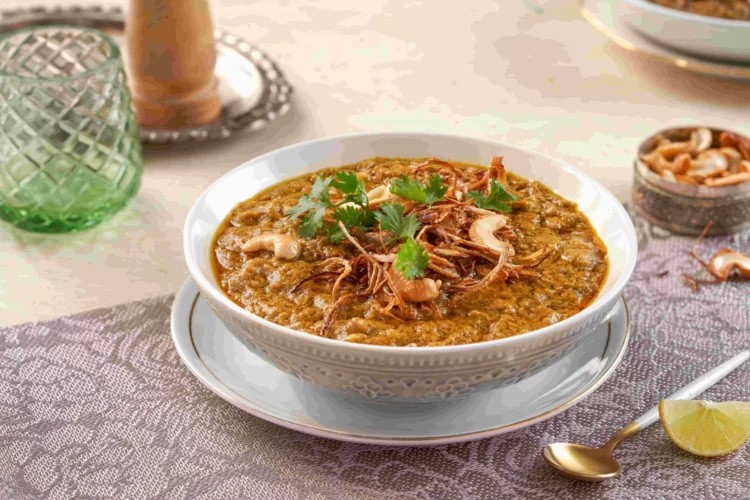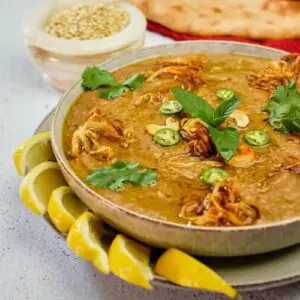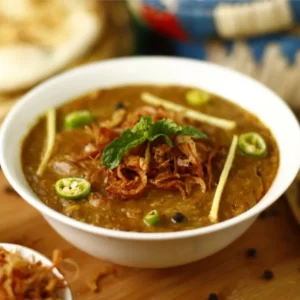Introduction
Are you ready to embark on a culinary journey that will tantalize your taste buds and leave you craving for more? Look no further because we are about to delve into the world of Haleem, a flavorful and hearty dish that has captured the hearts of food enthusiasts around the globe. In this comprehensive guide, we will explore the origins, ingredients, cooking methods, and variations while also providing answers to frequently asked questions. So, let’s dive in and discover the wonders of this delightful dish!
Haleem: A Fusion of Flavors
Haleem, also known as Harees, is a rich and aromatic dish that originated in the Middle East and has become popular in various regions, including South Asia. It is a savory porridge-like dish made by slow-cooking a combination of meat, lentils, wheat, and spices. The result is a velvety textured delicacy that is often enjoyed during festive occasions, especially Ramadan.
History
It has a fascinating history that dates back centuries. It is believed to have originated in the Arabian Peninsula, where it was introduced by Arab traders and later embraced by the Indian subcontinent. Over time, different regions have added their unique twist to the recipe, resulting in a diverse range of Haleem variations.
Ingredients:
- Meat: Traditionally, lamb or mutton is used in Haleem. The meat is slow-cooked until tender and then shredded or finely minced, adding a rich and meaty taste.
- Wheat: Whole wheat grains or broken wheat (also known as cracked wheat or bulgur) are essential in creating the base of of the dish. The wheat is soaked, boiled, and later cooked with the meat to create a thick and creamy consistency.
- Lentils: Split yellow lentils (commonly known as chana dal) or a combination of lentils are often added to enhance the texture and flavor of Haleem. The lentils are cooked until they melt into the dish, giving it a creamy and velvety finish.
- Spices: Haleem is a medley of aromatic spices that infuse the dish with depth and complexity. Common spices used include ginger, garlic, turmeric, cumin, coriander, cardamom, cloves, and cinnamon.
- Ghee or Oil: Ghee (clarified butter) or oil is used for cooking meat and spices, adding richness and enhancing the overall flavor profile.
Ingredients:
- 1 cup wheat grains
- 1/2 cup broken wheat (daliya)
- 1/2 cup yellow lentils (split yellow moong dal)
- 1/2 cup Bengal gram (chana dal)
- 1/2 cup meat (mutton or chicken), boneless and cut into small pieces
- 2 onions, finely chopped
- 2 tablespoons ginger-garlic paste
- 2 teaspoons red chili powder
- 1 teaspoon turmeric powder
- 1 teaspoon garam masala powder
- Salt to taste
- 4 tablespoons cooking oil or ghee (clarified butter)
- 1/4 cup fried onions, for garnishing
- Fresh coriander leaves, chopped, for garnishing
- Ginger, julienned, for garnishing
- Lemon wedges, for serving
Cooking Methods: Slow and Steady Wins the Race
The key to achieving the perfect texture and taste lies in the cooking method. Traditionally, it is cooked on low heat for several hours, allowing the flavors to meld together and create a harmonious blend. Let’s explore two popular cooking methods used to prepare this delectable dish:
1. Traditional Stovetop Cooking
In this method, a large pot or cauldron is used to slow-cook the Haleem. Here’s a step-by-step guide to preparing on a stovetop:
- Heat ghee or oil in a large pot and sauté onions until golden brown.
- Add meat, ginger-garlic paste, and spices to the pot. Cook until the meat is browned and the spices release their aromas.
- Rinse the lentils and wheat thoroughly. Add them to the pot along with water, ensuring the ingredients are fully submerged.
- Reduce the heat to low and simmer the mixture for several hours, stirring occasionally to prevent sticking. As the Haleem cooks, the grains and lentils will break down, creating a thick and creamy consistency.
- Once the meat is tender and the Haleem has reached the desired consistency, adjust the seasoning if needed.
- Serve the dish hot, garnished with fried onions, fresh coriander, ginger slices, and a squeeze of lemon juice.
2. Modern Pressure Cooker Method
If you’re short on time but still want to enjoy the flavors, a pressure cooker can be your best friend. Follow these steps for a quicker version of Haleem:
- Heat ghee or oil in a pressure cooker and sauté onions until golden brown.
- Add meat, ginger-garlic paste, and spices to the cooker. Cook until the meat is browned and the spices release their aromas.
- Rinse the lentils and wheat thoroughly. Add them to the cooker along with water, ensuring the ingredients are fully submerged.
- Close the pressure cooker lid and cook on high pressure for about 45 minutes to 1 hour, depending on the tenderness of the meat.
- Allow the pressure to release naturally before opening the cooker. The grains and lentils will have cooked down, resulting in a thick and creamy Haleem.
-
Adjust the seasoning if needed and serve the Haleem piping hot, garnished with your choice of toppings.
Variations:
- Hyderabadi: This version hails from the city of Hyderabad in India and is known for its rich and indulgent flavors. It incorporates boneless meat, wheat, lentils, and a blend of aromatic spices. Hyderabadi Haleem is traditionally garnished with fried onions, fresh mint, and a dollop of ghee.
- Pakistani: Pakistani Haleem is a beloved dish that is often prepared during the Islamic month of Ramadan. It features a combination of meat, wheat, and lentils, slow-cooked to perfection. The addition of ghee and fried onions adds a delightful richness to the dish.
- Bangladeshi: In Bangladesh, Haleem is made with a unique twist by incorporating boneless fish fillets. This seafood variation offers a lighter and refreshing take on the traditional Haleem recipe.
- Iranian: Iranian Haleem, known as “Haleem-e Sabzi,” is a vegetarian version of the dish. It replaces meat with a medley of fresh herbs, such as parsley, coriander, and fenugreek, along with wheat and lentils. The result is a vibrant and herbaceous Haleem that is packed with flavor.
FAQs
- 1. What is the origin of Haleem?
Haleem originated in the Middle East and was introduced to the Indian subcontinent by Arab traders.
- 2. Is Haleem suitable for vegetarians?
While traditional Haleem is made with meat, vegetarian variations can be prepared by substituting meat with vegetables or lentils.
- 3. Can I freeze Haleem?
Yes, it can be frozen for future consumption.
Ensure that it is properly stored in an airtight container or freezer bag to maintain its flavor and texture.
- 4. Can Haleem be made with different types of meat?
Absolutely! While lamb or mutton is commonly used in this recipe, you can experiment with other meats such as chicken, beef, or even seafood, depending on your preference.
- 5. Can Haleem be enjoyed outside of Ramadan?
Definitely! While it is often associated with Ramadan due to its popularity as an iftar dish, it can be savored throughout the year. Its hearty and comforting nature makes it a delightful meal for any occasion.
- 6. Can I adjust the spice level?
Certainly! The spice level can be customized according to your taste preferences. You can increase or decrease the amount of spices used or add additional chili powder or peppers to achieve your desired level of heat.
Conclusion
In conclusion, Haleem is a culinary masterpiece that showcases the harmonious blend of meat, lentils, wheat, and aromatic spices. Its origins in the Middle East have paved the way for various regional variations, each with its own unique twist. Whether you choose to savor the rich and indulgent Hyderabadi Haleem or the refreshing Bangladeshi fish Haleem, this dish is sure to leave a lasting impression on your taste buds. So, gather your ingredients, embrace the slow cooking process, and immerse yourself in the delightful world!
The Ultimate Guide to Haleem: A Delectable Dish Explained
Haleem, also known as Harees, is a rich and aromatic dish that originated in the Middle East and has become popular in various regions, including South Asia. It is a savory porridge-like dish made by slow-cooking a combination of meat, lentils, wheat, and spices. The result is a velvety textured delicacy that is often enjoyed during festive occasions, especially Ramadan.
Ingredients
- 1 cup wheat grains
- 1/2 cup broken wheat (daliya)
- 1/2 cup yellow lentils (split yellow moong dal)
- 1/2 cup Bengal gram (chana dal)
- 1/2 cup meat (mutton or chicken), boneless and cut into small pieces
- 2 onions, finely chopped
- 2 tablespoons ginger-garlic paste
- 2 teaspoons red chili powder
- 1 teaspoon turmeric powder
- 1 teaspoon garam masala powder
- Salt to taste
- 4 tablespoons cooking oil or ghee (clarified butter)
- 1/4 cup fried onions, for garnishing
- Fresh coriander leaves, chopped, for garnishing
- Ginger, julienned, for garnishing
- Lemon wedges, for serving
Instructions
1. Traditional Stovetop Cooking
- Heat ghee or oil in a large pot and sauté onions until golden brown.
- Add meat, ginger-garlic paste, and spices to the pot. Cook until the meat is browned and the spices release their aromas.
- Rinse the lentils and wheat thoroughly. Add them to the pot along with water, ensuring the ingredients are fully submerged.
- Reduce the heat to low and simmer the mixture for several hours, stirring occasionally to prevent sticking. As the Haleem cooks, the grains and lentils will break down, creating a thick and creamy consistency.
- Once the meat is tender and the Haleem has reached the desired consistency, adjust the seasoning if needed.
- Serve the Haleem hot, garnished with fried onions, fresh coriander, ginger slices, and a squeeze of lemon juice.
2. Modern Pressure Cooker Method
If you're short on time but still want to enjoy the flavors of Haleem, a pressure cooker can be your best friend. Follow these steps for a quicker version of Haleem:
- Heat ghee or oil in a pressure cooker and sauté onions until golden brown.
- Add meat, ginger-garlic paste, and spices to the cooker. Cook until the meat is browned and the spices release their aromas.
- Rinse the lentils and wheat thoroughly. Add them to the cooker along with water, ensuring the ingredients are fully submerged.
- Close the pressure cooker lid and cook on high pressure for about 45 minutes to 1 hour, depending on the tenderness of the meat.
- Allow the pressure to release naturally before opening the cooker. The grains and lentils will have cooked down, resulting in a thick and creamy Haleem.
Adjust the seasoning if needed and serve the Haleem piping hot, garnished with your choice of toppings.
Nutrition Information:
Amount Per Serving: Calories: 350-400Total Fat: 10-15gCarbohydrates: 50-60gFiber: 8-10gProtein: 20-25g
Nutrition
| Calories | 145kcal |
| Carbohydrates | 19gm |
| proteins | 3g |
| sodium | 180mg |
| potassium | 270mg |
| sugar | 23g |
| Vitamin A | 7IU |
| Vitamin C | 8mg |
| Fat | 6g |
| Iron | 1mg |
Also, read:
follow us on instagram, facebook and youtube
============================================




